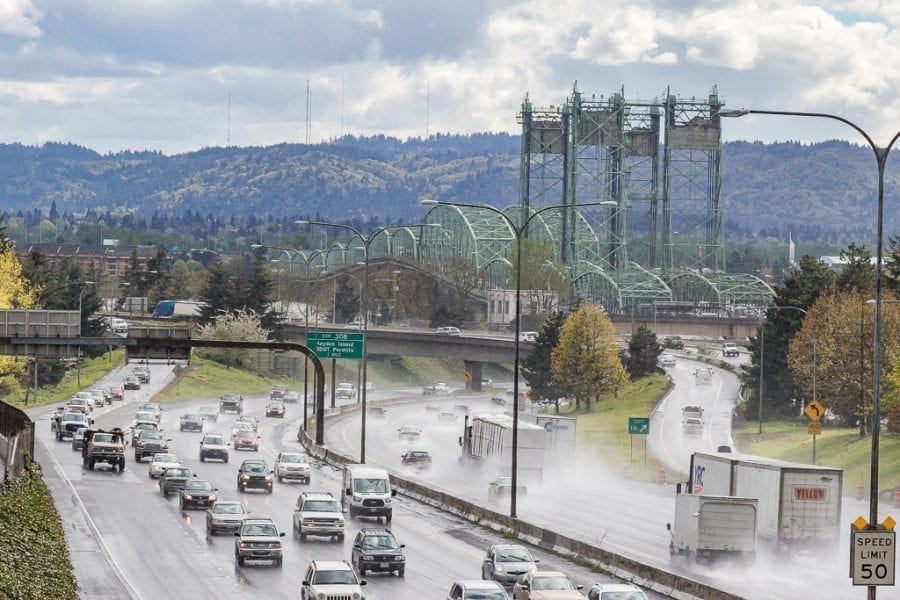John Ley
For ClarkCountyToday.com

VANCOUVER — The original span of the Interstate 5 (I-5) bridge was opened in 1917. It was the first automobile bridge across the Columbia River between Washington and Oregon, and the second bridge to span the river at all, after the Wenatchee Bridge of 1908.
Is the I-5 Bridge safe?
According to a list of “structurally deficient” bridges in Washington state, as reported by the Seattle Times in May 2013, there is only one listed in Clark County. (Hint — it’s not the I-5 Bridge. It is a bridge crossing the east fork of the Lewis River on I-5.)
The list shows 143 bridges. Of those, 12 were “fracture critical” that carry 10,000 or more vehicles per day (no I-5 Bridge here.) Next were 20 are other “fracture critical” bridges (no I-5 Bridge listed.)
Next were 66 bridges with a sufficiency rating of 50 or lower (the I-5 Bridge is not listed.)
Finally, there were 81 “structurally deficient” bridges built over 50 years ago, with a sufficiency rating of 50 or less (the I-5 Bridge was not listed).
So is the Washington State Department of Transportation (WSDOT) not being truthful to the citizens of Washington, in reporting “structurally deficient” bridges? I don’t think so.
WSDOT in January 2017 updated their report to citizens. There are two more bridges on the list of 145 bridges. The I-5 Bridge remains safe according to WSDOT. There is only one bridge in Clark County listed as “structurally deficient,” and it’s not the I-5 Bridge.
Both WSDOT and the Oregon Department of Transportation (ODOT) deem the bridge structures “safe” for the next five decades.
“I-5 bridge across Columbia ‘functionally obsolete’ but safe ODOT says,” reports KATU television in Portland. “It is categorized as “functionally obsolete.”
That sounds bad but according to ODOT that does not mean the bridge is unsafe. It means it was built to outdated construction standards: narrow lanes, narrow shoulders and not built for the volume of traffic these days.
Furthermore, ODOT reports:
“A classification of ‘structurally deficient’ does not imply that bridges are unsafe. When an inspection reveals a safety problem, the bridge is posted for reduced loads, scheduled for repairs, or in unusual situations, closed until repairs can be completed.”
Page 50 of a 2015 ODOT Bridge Condition Report report lists the I-5 Bridge. It is not listed as “structurally deficient.’’

What is the oldest steel bridge in the nation?
The Eads Bridge in St. Louis holds the honor of being the oldest steel bridge in the nation, according to Wikipedia. It was built in 1874 and crosses the Mississippi River. It still serves it’s community and is a historic treasure. The St. Louis Landmark is listed on the National Register of Historic Places, as a National Historic Landmark. As of April 2014, it carries about 8,100 vehicles daily.
Is the Interstate 5 bridge the oldest steel bridge in the region?
- The BNSF rail bridge was built in 1908.
- The Hawthorne Bridge was built in 1910.
- The Steel Bridge was built in 1912.
- The Broadway Bridge was built in 1913.
- The I-5 Bridge (the northbound structure today) was opened in 1917.
Earthquakes
In the last century, the biggest magnitude earthquake has been a 7.1 in the Pacific Northwest, according to the Oregon Department of Geology and Mineral Industries.
- April 13, 1949 — magnitude 7.1, Olympia, eight killed and $150 million in damage in Washington, minor damage in Northwest Oregon. This was the largest and best documented quake in the Northwest and was felt over 230,000 square miles.
- Nearly 17,000 earthquakes of magnitude 1.0 to 6.0 have been recorded in Oregon and Washington since 1970. About 15-20 quakes a year are felt in the Northwest. Earthquakes are usually felt if they are at least magnitude 3 to 4.
So why all the hype? We don’t experience California-type earthquakes.
The biggest natural disaster local citizens discuss is the Columbus Day Storm in 1962. Overall, rains and flooding cause much more damage here in the Pacific Northwest than earthquakes ever have. This would include landslides triggered by heavy rains. The Oso mudslide being our most recent. Forty-three people were killed and 49 homes or structures were destroyed in this landslide.
A seismic upgrade would be a prudent thing for all of our regional bridges. It has been estimated it would cost $200 million for a seismic upgrade to the I-5 Bridge.
ODOT recently completed some initial seismic upgrades to I-5 from the southern end of Portland to the Tualatin River. This was the result of a report indicating:
“Only a small portion of I-5 would remain passable if the state suffered a substantial seismic event; most of the older bridges would either collapse or experience severe damage and become impassable without major and very costly repair work,” ODOT reported.
Yet none of the work was done on the I-5 Bridge. Why? Because it isn’t “structurally deficient”. Other bridges represented a greater “risk.”
Treasuring our historic bridge
We need to treasure and preserve our I-5 Bridge. It is a piece of our history. It remains safe and serves our community. While it is aging, with proper maintenance it can continue serving the Portland metropolitan region for another century.
John Ley is a resident of Camas and an active participant in issues that impact Clark County residents.





Any structure can be maintained or replaced. I suggest continuing good maintenance why building two new bridge corridors over the Columbia to reduce the traffic volume on the I5 & 205 bridge corridors.